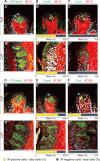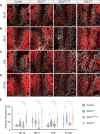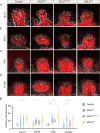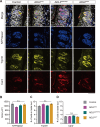Phosphorylated Tau in the Taste Buds of Alzheimer's Disease Mouse Models
- PMID: 39266476
- PMCID: PMC11411091
- DOI: 10.5607/en24004
Phosphorylated Tau in the Taste Buds of Alzheimer's Disease Mouse Models
Abstract
Numerous systemic diseases manifest with oral symptoms and signs. The molecular diagnosis of Alzheimer's disease (AD), the most prevalent neurodegenerative disease worldwide, currently relies on invasive or expensive methods, emphasizing the imperative for easily accessible biomarkers. In this study, we explored the expression patterns of key proteins implicated in AD pathophysiology within the taste buds of mice. We detected the expression of amyloid precursor protein (APP) and tau protein in the taste buds of normal C57BL/6 mice. Phosphorylated tau was predominantly found in type II and III taste cells, while APP was located in type I taste cells. Remarkably, we observed significantly stronger immunoreactivity to phosphorylated tau in the taste buds of aged AD mouse models compared to age-matched controls. These findings underscore the oral expression of biomarkers associated with AD, highlighting the diagnostic potential of the oral cavity for neurodegenerative diseases.
Keywords: Alzheimer’s disease; Amyloid protein precursor; Immunohistochemistry; Taste buds; Tauopathies.
Figures





Similar articles
-
Abnormal interaction of VDAC1 with amyloid beta and phosphorylated tau causes mitochondrial dysfunction in Alzheimer's disease.Hum Mol Genet. 2012 Dec 1;21(23):5131-46. doi: 10.1093/hmg/dds360. Epub 2012 Aug 27. Hum Mol Genet. 2012. PMID: 22926141 Free PMC article.
-
Stress kinases involved in tau phosphorylation in Alzheimer's disease, tauopathies and APP transgenic mice.Neurotox Res. 2004;6(6):469-75. doi: 10.1007/BF03033283. Neurotox Res. 2004. PMID: 15658002
-
Lipidomic analysis of brain tissues and plasma in a mouse model expressing mutated human amyloid precursor protein/tau for Alzheimer's disease.Lipids Health Dis. 2013 May 9;12:68. doi: 10.1186/1476-511X-12-68. Lipids Health Dis. 2013. PMID: 23659495 Free PMC article.
-
Modeling Alzheimer's disease in transgenic mice: effect of age and of presenilin1 on amyloid biochemistry and pathology in APP/London mice.Exp Gerontol. 2000 Sep;35(6-7):831-41. doi: 10.1016/s0531-5565(00)00149-2. Exp Gerontol. 2000. PMID: 11053674 Review.
-
Tau proteins in blood as biomarkers of Alzheimer's disease and other proteinopathies.J Neural Transm (Vienna). 2022 Feb;129(2):239-259. doi: 10.1007/s00702-022-02471-y. Epub 2022 Feb 17. J Neural Transm (Vienna). 2022. PMID: 35175385 Review.
References
LinkOut - more resources
Full Text Sources
Molecular Biology Databases

